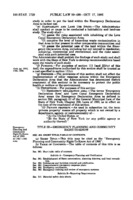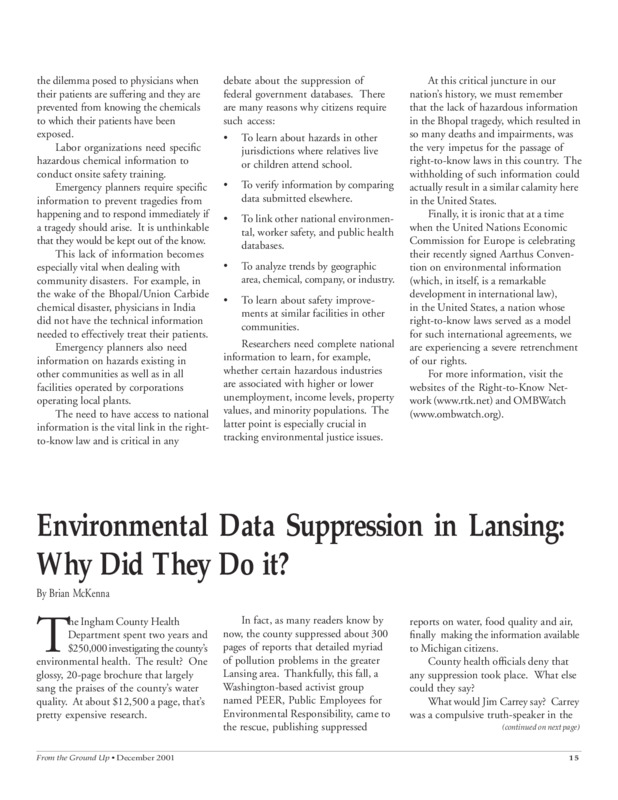Government Suppression of Environmental & Health Data
In the early 2000’s, state governments and corporations worked to impede public access to environmental data, particularly with respect to exposure to chemicals and toxins.While this took many forms, the Patriot Act and other tied legislation led to an insurgence of data suppression in the aftermath of the 9/11 terrorist attacks. The state of Michigan specifically experienced this on the local level during the tail end of Governor Engler’s Administration.
Federal Suppression of Environmental Data in the Post-9/11 Period
The Post-9/11 era saw a shift in America’s sense of security. President George W. Bush signed the Patriot Act into law in October 2001, increasing government surveillance of citizens; The Bush administration instituted new government offices, such as the Department of Homeland Security; and Islamophobia, as well as xenophobia more generally, became increasingly pervasive and widespread. The aftermath of the attack seemed to seep into almost every facet of American life – including environmental efforts.
By early 2002, nearly 20 websites that either states or the federal government oversaw removed information or deleted their sites entirely. Agencies such as the Environmental Protection Agency, Federal Aviation Administration, and NASA’s Glenn Research Center (among many others), as well as the Departments of Transportation and Energy, removed maps, databases, subsidiary websites, pipeline routes, chemical storage information, and public access to a plethora of files and archives. The Nuclear Regulatory Commission removed its website entirely. The FBI, EPA, chemical lobbyists, and government officials claimed that such information could aid terrorist efforts. As fear reigned in the aftermath of the terrorist attack, PEW Research Center reported that 69% of Americans supported the government doing whatever it could to keep information out of the hands of terrorists, even if that meant the public was deprived of such information as well. The Ecology Center and other organizations like the Sierra Club and Greenpeace, however, were skeptical of the widespread removal of environmental data. Since the passage of the Emergency Planning and Community Right-to-Know Act in 1986 – which granted the public access to information about chemicals present in the air, land, and water – corporations had been pushing for public limitations to that exact data, efforts to which the GOP was fairly sympathetic.
With respect to these reforms, the Ecology Center’s biggest concern involved the removal of Risk Management Plans (RMP) from the EPA’s website. These plans provided critical information about the dangers of chemical accidents and detailed how to prevent them in the first place by including a list of chemicals used at a certain plant, an official hazard assessment, a prevention program, and an emergency response plan. “The next logical step would be to confiscate road maps and close libraries, because the basic information is all there as well,” noted Rick Hind of the Greenpeace Toxics Campaign, the Ecology Center’s partner. “Any cursory reading of chemical engineering text books will show you that facilities making and using large amounts of chemicals such as chlorine have the potential for a catastrophic leak of poison gas.”
In response, the Ecology Center’s Children’s Environmental Health Network, in conjunction with the American Public Health Association and others, released a “Statement on Protecting Public Health and Hazards Reduction (Chemical Plants, Terrorism, and Right-to-Know)” to Congress that argued how right-to-know plays a crucial role in any democracy. The letter highlighted how “information about hazardous chemicals allows citizens as well as their elected representatives to make informed choices about their own and their community’s health and safety and enables health practitioners to better recognize and treat conditions related to environmental exposure.”
Gregory Button, a research associate at the Ecology Center who worked extensively on this issue, articulated numerous reasons why public access to environmental data was needed. He explained that the issue stretched beyond public health, noting how researchers need national data to determine “whether hazardous industries are associated with higher or lower unemployment, income levels, property values, and minority populations” which “is especially crucial in tracking environmental justice issues.” Due to continued pressure from the environmental community, the EPA eventually made RMP information accessible to the public again. The process of data being made available was generally piecemeal and slow in the time following 9/11, and ultimately took many years.
The fear of terrorists utilizing chemical plants to attack citizens did not dissipate quickly, though, but rather permeated the national consciousness for years to come. Furthermore, even though this necessary information was again made widely accessible, environmental deregulation and deferring to companies to fix site violations had catastrophic results. On August 5th, 2005, an explosion occurred at the Environmental Quality Resource Recovery chemical plant in Romulus, Michigan. That day, workers heard an ammonia tank start hissing. They quickly evacuated before it exploded, but the explosion caused the other tanks in the building to catch fire. Authorities initially suspected that a terrorist plane had slammed into the Environmental Quality Resource Recovery facility. Locals were scared of an attack scenario as well when they first saw the “black mushroom cloud” forming over their homes, parks, and schools that spread “black, sticky, hamburger-like debris.” One resident, Aurora Martin, said she “never even knew there was a chemical factory over there.” In the immediate aftermath, residents suffered burning sensations in their lungs and were advised not to touch the debris that showered the surface area immediately surrounding the plant. The plant itself had been cited 68 times since 1985 for violations, while an inspection in May 2005, just three months prior to the explosion, found three violations, “including one for not storing hazardous waste in the areas specified by its license.” Despite fears of this being an act of terrorism, culpability for this devastating fire fell instead on corporate mismanagement, greed, and disregard for its host population.
Ingham County’s Costly Data Suppression in September 2001
By the early 2000s, Ingham County had developed a track record of neglecting to address environmental hazards in their community. For example, in 1953 a fuel oil truck had pumped over 900 gallons of heating oil down an abandoned well in Holt, Michigan. Although it had initially been classified as a major contamination zone, in the following half century the state “delisted” the site, offering the County an opportunity to neglect their responsibility to conduct cleanup operations. Issues with Leaking Underground Storage Tanks (LUSTS), abandoned wells (including the one in Holt), and contaminates dumped below the surface of a former Motor Wheel Company waste site – all of which, if addressed in a timely fashion rather than left for decades, could have been contained – began to infiltrate the Saginaw Aquifer, Ingham County’s drinking water source.
After spending two years and $250,000 investigating its environmental health, the Ingham County Health Department released in December of 2000 a 20-page brochure that “largely sang the praises of the county’s water quality” according to Brian McKenna, a researcher who had contributed to the County’s investigation and wrote for Lansing’s City Pulse. McKenna knew that the County was misleading residents about the extent of the environmental problems he and his colleagues had uncovered during their research. He leaked over 300 pages of reports that the county had suppressed regarding water, food, and air quality to Public Employees for Environmental Responsibility (PEER). After the findings were published in September 2001, Ingham County officials denied that any data suppression had taken place.
Shortly afterwards the Ecology Center invited McKenna to write a piece for their bimonthly publication From the Ground Up. Rather than detail the findings, the Ecology Center and McKenna wanted to take a deeper look as to why Ingham County would hide such vital information from its residents. Since he had worked within the County Health Department, McKenna had special insight into their potential motivations, which he boiled down to over a dozen reasons, the most prominent being:
- Government being torn between the “contradictory roles of supporting economic development and serving the public at large.”
- Concerns about the political consequences during local officials re-election campaigns.
- Government’s conservative notion of scientific proof and its tendency to not act preventatively.
- It offered proof that the Ingham County Health Department was not doing its job well.
- Local officials were rather shocked at the findings, and were consequently in denial of the report’s severity.
- Fear of offending Governor Engler’s Department of Environmental Quality.
While all these reasons likely contributed to the suppression of local data, McKenna attributed the report’s omission of information about the Holt contamination site to Ingham County’s fear of offending the Michigan Department of Environmental Quality (MDEQ) under Governor Engler, since it would inherently highlight the state government’s failure to acknowledge, much less remove, the contamination. Both Ingham County and the Health Department specifically were beholden to the Governor for financial support, making the choice to suppress the information for their convenience even easier.
Article written by Lily Antor, member of the Spring/Summer 2020 Research team.



